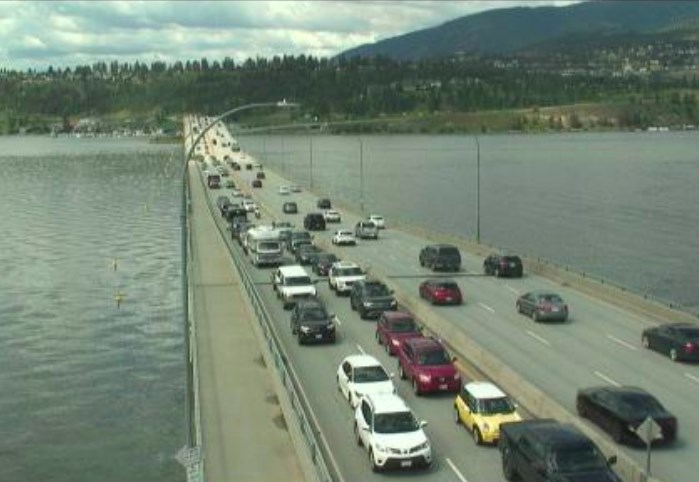No second bridge over Okanagan Lake in Kelowna for at least 20 years: MOT
A new Central Okanagan transportation plan, almost a decade in the making, rules out the possibility of a second bridge over Okanagan Lake – at least for the next 20 years.
Staff from the Ministry of Transportation presented their Central Okanagan Integrated Transportation Strategy to Kelowna city council today, March 13.
The work dates back to 2014 when a second crossing and a bypass were very much top of mind, council was told and it was considered as part of the latest plan.
“A second crossing doesn’t solve the problems that you think it would,” council was told by the ministry staff.
Very few people travel all the way through the Central Okanagan, so a bypass would be a very expensive option that few people would use, council was told.
Less than 5% of traffic goes all the way through the region and only about 1% of trucks. Kelowna is the key destination that people want to get in and out of, they were told.
The provincial strategy is integrated with recent municipal and regional transportation studies so the province took into account what local governments want.
The vision is for Highway 97 to be a more of an urban street with stop lights through Kelowna from Abbott Street to Highway 33 with no interchanges. In more rural areas, like Boucherie Road, Westlake Roads and Kelowna airport, interchanges are in the plans.
The ministry is also working with West Kelowna so they can get rid to the “couplet” through Westbank.
Transit is key to moving people more effectively.
On the West Kelowna side, they are looking at more local routes in places like Shannon Lake and Boucherie Road that would go to the Queensway station in downtown Kelowna instead of riders having to transfer to other buses.
Shoulder lanes along the highway through West Kelowna will help speed up buses, as will a dedicated bus lane on the bridge and through Kelowna eventually, leading to a bus route down the middle of the highway from Abbott Street to Highway 33.
A bus lane on the bridge would mean adding a sixth lane.
They are also looking at direct bus routes from downtown Kelowna to Rutland and Lake Country. That will allow Lake Country riders, for example, to avoid transferring at UBC Okanagan.
READ MORE: Don’t hold your breath waiting for transit to ease gridlock on the highway through Kelowna
Now that the plan is in place, it will take years before anything major, like an extension of Clement Avenue through to Highway 33, is actually built.
There's no construction funding in place for any of the projects and, even if there was, it will take three to five years to actually do the work.
In terms of transit, there are now about 200 people per hour on four buses in the peak times crossing the bridge. That needs to grow to 500 to 700 per hour on about 12 buses before the dedicated bus lanes would be justified.
To contact a reporter for this story, email Rob Munro or call 250-808-0143 or email the editor. You can also submit photos, videos or news tips to the newsroom and be entered to win a monthly prize draw.
We welcome your comments and opinions on our stories but play nice. We won't censor or delete comments unless they contain off-topic statements or links, unnecessary vulgarity, false facts, spam or obviously fake profiles. If you have any concerns about what you see in comments, email the editor in the link above.




